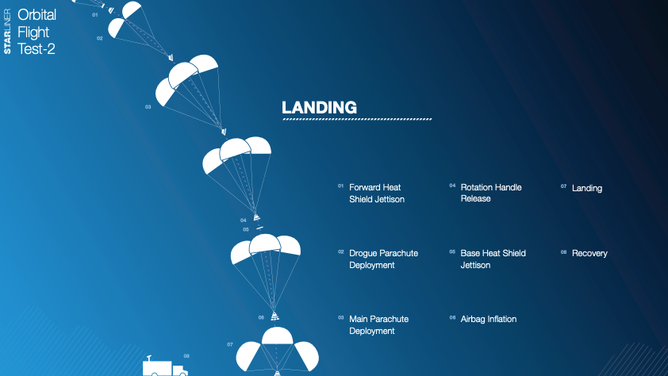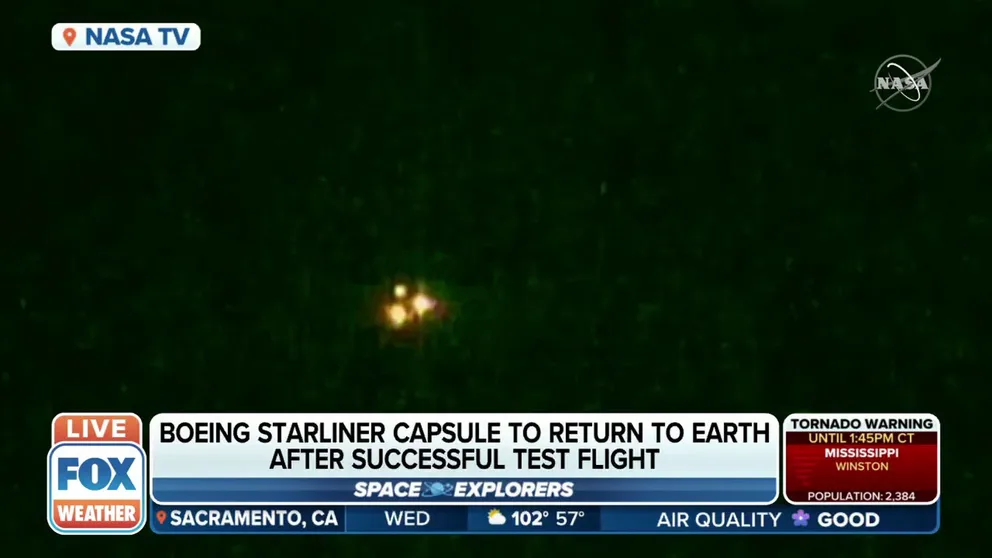'Picture perfect landing': Boeing's Starliner lands in New Mexico after first visit to ISS
2 years in the making: Boeing completes Starliner orbital flight test, inching closer to launching astronauts
Boeing's Starliner capsule lands safely back on Earth
Boeing’s Starliner capsule lands safely back on Earth after visiting the International Space Station
Boeing's CST-100 Starliner spacecraft successfully landed in New Mexico, wrapping up a six-day mission.
At 4:49 p.m. MT, NASA’s Boeing Orbital Flight Test-2 (OFT) touched down at White Sands Space Harbor at the U.S. Army’s White Sands Missile Range in New Mexico.
"It was a picture-perfect landing at the White Sands Space Harbor. Starliner hit another bull's-eye. I think the landing point was about 500 meters or so from where it was intended just due to the winds being a little different than what was predicted," said Steve Stich, NASA’s Commercial Crew Program Manager.
The spacecraft returned with more than 600 pounds of cargo, including Nitrogen Oxygen Recharge System reusable tanks that provide breathable air to station crew members, NASA said.
HOW TO WATCH FOX WEATHER ON TV
Onboard the Starliner was a manikin named "Rosie the Rocketeer," who had sensors in her seat to collect data to improve the experience for the first human passengers.
Wednesday’s touchdown reached a milestone as it was Boeing’s final test before flying astronauts.
After reviewing the data from the OFT, NASA could approve Starliner to fly astronauts later this year.
"The next is to really now dig down into all the details of the mission with looking at all the instrumentation, so all of the subsystems. We’ll look at all subsystems in much more detail to make sure that we saw everything that what we wanted to and got the expected results. So after that, we’ll have a lot more confidence to turn the vehicle around for the next mission," said Mark Nappi, Vice President and Program Manager of the Boeing Commercial Crew Program.
Boeing developed the spacecraft as part of NASA's Commercial Crew Program. SpaceX's Crew Dragon has successfully launched four long-duration astronaut missions to the ISS for NASA as part of the program.
Last week, Starliner launched to the space station from Cape Canaveral, Florida, on a United Launch Alliance Atlas V, arriving at the space station the next day. This was the second time in orbit for the vehicle designed to fly NASA astronauts to and from the ISS, but the first visit to the space station. A 2019 attempt to complete the OFT ended without docking at the ISS because of a computer glitch.
Boeing Starliner undocks from ISS, begins journey back to Earth
Boeing's CST-100 Starliner spacecraft undocked from the International Space Station Wednesday and will later land in the New Mexico desert.
HOW THE END OF GRAVITY WOULD MEAN THE END OF THE WORLD
Starliner spent about four days docked at the ISS, during which the astronauts explored the spacecraft and conducted some communication tests.
The spacecraft undocked at 2:36 p.m. ET, just one minute after a SpaceX rocket launched from Earth about 200 miles below.
The landing

Boeing's CST-100 Starliner landing timeline from re-entry to landing. (Image: Boeing)
When Starliner returned to Earth, it was forced to slow from around 17,500 mph to nearly zero for a soft touchdown.
The first step was a deorbit burn before Starliner hit Earth's atmosphere. The spacecraft's heat shield protected it from 3,000-degree temperatures as it barreled through the atmosphere.
CLICK HERE TO GET THE FOX WEATHER UPDATE PODCAST
Two drogue parachutes deployed at 30,000 feet above the ground before three main parachutes. Finally, at 3,000 feet, airbags inflated around the spacecraft for landing.

